Extracorporeal shock wave lithotripsy (ESWL) versus percutaneous nephrolithotomy (PCNL) or retrograde intrarenal surgery (RIRS) for kidney stones
- PMID: 37526261
- PMCID: PMC10392035
- DOI: 10.1002/14651858.CD007044.pub4
Extracorporeal shock wave lithotripsy (ESWL) versus percutaneous nephrolithotomy (PCNL) or retrograde intrarenal surgery (RIRS) for kidney stones
Abstract
Background: Nephrolithiasis is a common urological disease worldwide. Extracorporeal shock wave lithotripsy (ESWL) has been used for the treatment of renal stones since the 1980s, while retrograde intrarenal surgery (RIRS) and percutaneous nephrolithotomy (PCNL) are newer, more invasive treatment modalities that may have higher stone-free rates. The complications of RIRS and PCNL have decreased owing to improvement in surgical techniques and instruments. We re-evaluated the best evidence on this topic in an update of a Cochrane Review first published in 2014.
Objectives: To assess the effects of extracorporeal shock wave lithotripsy compared with percutaneous nephrolithotomy or retrograde intrarenal surgery for treating kidney stones.
Search methods: We performed a comprehensive search in CENTRAL, MEDLINE, Embase, and ClinicalTrials.gov with no restrictions on language or publication status. The latest search date was 6 December 2022.
Selection criteria: We included randomized controlled trials (RCTs) and quasi-RCTs that compared ESWL with PCNL or RIRS for kidney stone treatment.
Data collection and analysis: Two review authors independently classified studies, extracted data, and assessed risk of bias. Our primary outcomes were treatment success rate at three months (defined as residual fragments smaller than 4 mm, or as defined by the study authors), quality of life (QoL), and complications. Our secondary outcomes were retreatment rate, auxiliary procedures rate, and duration of hospital stay. We performed statistical analyses using a random-effects model and independently rated the certainty of evidence using the GRADE approach.
Main results: We included 31 trials involving 3361 participants (3060 participants completed follow-up). Four trials were only available as an abstract. Overall mean age was 46.6 years and overall mean stone size was 13.4 mm. Most participants (93.8%) had kidney stones measuring 20 mm or less, and 68.9% had lower pole stones. ESWL versus PCNL ESWL may have a lower three-month treatment success rate than PCNL (risk ratio [RR] 0.67, 95% confidence interval [CI] 0.57 to 0.79; I2 = 87%; 12 studies, 1303 participants; low-certainty evidence). This corresponds to 304 fewer participants per 1000 (397 fewer to 194 fewer) reporting treatment success with ESWL. ESWL may have little or no effect on QoL after treatment compared with PCNL (1 study, 78 participants; low-certainty evidence). ESWL probably leads to fewer complications than PCNL (RR 0.62, 95% CI 0.47 to 0.82; I2 = 18%; 13 studies, 1385 participants; moderate-certainty evidence). This corresponds to 82 fewer participants per 1000 (115 fewer to 39 fewer) having complications after ESWL. ESWL versus RIRS ESWL may have a lower three-month treatment success rate than RIRS (RR 0.85, 95% CI 0.78 to 0.93; I2 = 63%; 13 studies, 1349 participants; low-certainty evidence). This corresponds to 127 fewer participants per 1000 (186 fewer to 59 fewer) reporting treatment success with ESWL. We are very uncertain about QoL after treatment; the evidence is based on three studies (214 participants) that we were unable to pool. We are very uncertain about the difference in complication rates between ESWL and RIRS (RR 0.93, 95% CI 0.63 to 1.36; I2 = 32%; 13 studies, 1305 participants; very low-certainty evidence). This corresponds to nine fewer participants per 1000 (49 fewer to 48 more) having complications after ESWL.
Authors' conclusions: ESWL compared with PCNL may have lower three-month success rates, may have a similar effect on QoL, and probably leads to fewer complications. ESWL compared with RIRS may have lower three-month success rates, but the evidence on QoL outcomes and complication rates is very uncertain. These findings should provide valuable information to aid shared decision-making between clinicians and people with kidney stones who are undecided about these three options.
Trial registration: ClinicalTrials.gov NCT00873054.
Copyright © 2023 The Cochrane Collaboration. Published by John Wiley & Sons, Ltd.
Conflict of interest statement
VS: none AS: none SP: none BL: none PP: none
Figures
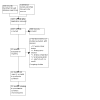
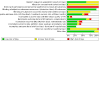
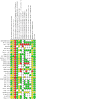
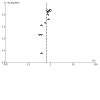
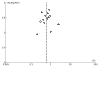
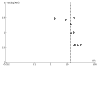
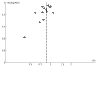
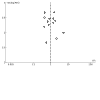
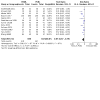
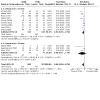

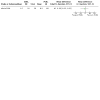
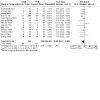
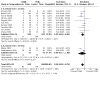
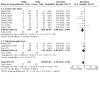
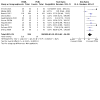
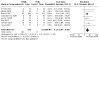
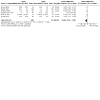
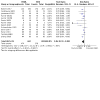
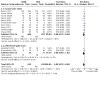
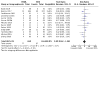
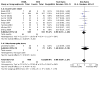
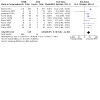
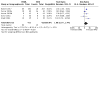
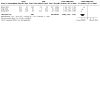
Update of
-
Extracorporeal shock wave lithotripsy (ESWL) versus percutaneous nephrolithotomy (PCNL) or retrograde intrarenal surgery (RIRS) for kidney stones.Cochrane Database Syst Rev. 2014 Nov 24;(11):CD007044. doi: 10.1002/14651858.CD007044.pub3. Cochrane Database Syst Rev. 2014. Update in: Cochrane Database Syst Rev. 2023 Aug 1;8:CD007044. doi: 10.1002/14651858.CD007044.pub4. PMID: 25418417 Updated. Review.
Similar articles
-
Percutaneous nephrolithotomy versus retrograde intrarenal surgery for treatment of renal stones in adults.Cochrane Database Syst Rev. 2023 Nov 13;11(11):CD013445. doi: 10.1002/14651858.CD013445.pub2. Cochrane Database Syst Rev. 2023. PMID: 37955353 Free PMC article. Review.
-
Extracorporeal shock wave lithotripsy (ESWL) versus percutaneous nephrolithotomy (PCNL) or retrograde intrarenal surgery (RIRS) for kidney stones.Cochrane Database Syst Rev. 2014 Nov 24;(11):CD007044. doi: 10.1002/14651858.CD007044.pub3. Cochrane Database Syst Rev. 2014. Update in: Cochrane Database Syst Rev. 2023 Aug 1;8:CD007044. doi: 10.1002/14651858.CD007044.pub4. PMID: 25418417 Updated. Review.
-
Extracorporeal shock wave lithotripsy (ESWL) versus percutaneous nephrolithotomy (PCNL) or retrograde intrarenal surgery (RIRS) for kidney stones.Cochrane Database Syst Rev. 2009 Oct 7;(4):CD007044. doi: 10.1002/14651858.CD007044.pub2. Cochrane Database Syst Rev. 2009. Update in: Cochrane Database Syst Rev. 2014 Nov 24;(11):CD007044. doi: 10.1002/14651858.CD007044.pub3. PMID: 19821393 Updated. Review.
-
Retrograde Intrarenal Surgery vs. Percutaneous Nephrolithotomy vs. Extracorporeal Shock Wave Lithotripsy for Lower Pole Renal Stones 10-20 mm : A Meta-analysis and Systematic Review.Urol J. 2019 May 5;16(2):97-106. doi: 10.22037/uj.v0i0.4681. Urol J. 2019. PMID: 30604405
-
Effectiveness of Percutaneous Nephrolithotomy, Retrograde Intrarenal Surgery, and Extracorporeal Shock Wave Lithotripsy for Treatment of Renal Stones: A Systematic Review and Meta-Analysis.Medicina (Kaunas). 2020 Dec 30;57(1):26. doi: 10.3390/medicina57010026. Medicina (Kaunas). 2020. PMID: 33396839 Free PMC article. Review.
Cited by
-
Percutaneous nephrolithotomy or flexible ureteral lithotripsy, which one is better for patients with upper ureteral calculi of 1.5-2.0 cm in diameter.BMC Urol. 2024 Apr 25;24(1):98. doi: 10.1186/s12894-024-01480-1. BMC Urol. 2024. PMID: 38664721 Free PMC article.
-
Visceral Adiposity and Its Impact on Nephrolithiasis: A Narrative Review.J Clin Med. 2024 Jul 11;13(14):4065. doi: 10.3390/jcm13144065. J Clin Med. 2024. PMID: 39064104 Free PMC article. Review.
-
Analyzing global research trends and focal points in the utilization of laser techniques for the treatment of urolithiasis from 1978 to 2022: visualization and bibliometric analysis.Urolithiasis. 2024 Apr 17;52(1):67. doi: 10.1007/s00240-024-01568-1. Urolithiasis. 2024. PMID: 38630266 Review.
-
Efficacy of music therapy for pain control of extracorporeal shock wave lithotripsy: A meta-analysis of randomized controlled studies.Medicine (Baltimore). 2024 May 31;103(22):e38182. doi: 10.1097/MD.0000000000038182. Medicine (Baltimore). 2024. PMID: 39259054 Free PMC article.
-
Percutaneous nephrolithotomy versus retrograde intrarenal surgery for treatment of renal stones in adults.Cochrane Database Syst Rev. 2023 Nov 13;11(11):CD013445. doi: 10.1002/14651858.CD013445.pub2. Cochrane Database Syst Rev. 2023. PMID: 37955353 Free PMC article. Review.
References
References to studies included in this review
AbdelRazek 2021 {published data only}
-
- AbdelRazek M, Abolyosr A, AbdelKader MS, Hassan AM, Hamed AA, Alsagheer G. Percutaneous nephrolithotomy versus extracorporeal shock wave lithotripsy for renal insufficiency. World Journal of Urology 2021;39(12):4477-82. [PMID: ] - PubMed
Ahmed 2021 {published data only}
-
- Ahmed AF, Abdelazim H, ElMesery M, El-Feky M, Gomaa A, Tagreda I, et al. Mini-percutaneous nephrolithotomy is a safe alternative to extracorporeal shockwave lithotripsy for high-density, renal stones: a prospective, randomised trial. BJU international 2021;128(6):744-51. [PMID: ] - PubMed
Albala 2001 {published data only}
-
- Albala DM, Assimos DG, Clayman RV, Denstedt JD, Grasso M, Gutierrez-Aceves J, et al. Lower pole I: a prospective randomized trial of extracorporeal shock wave lithotripsy and percutaneous nephrostolithotomy for lower pole nephrolithiasis-initial results. Journal of Urology 2001;166(6):2072-80. [MEDLINE: ] - PubMed
Atis 2021 {published data only}
-
- Atis G, Culpan M, Ucar T, Sendogan F, Kazan HO, Yildirim A. The effect of shock wave lithotripsy and retrograde intrarenal surgery on health-related quality of life in 10-20 mm renal stones: a prospective randomized pilot study. Urolithiasis 2021;49(3):247-53. [PMID: ] - PubMed
-
- Culpan M, Atis G, Sendogan F, Ucar T, Yildirim A, Caskurlu T. The effect of shock wave lithotripsy and retrograde intrarenal surgery on health-related quality of life in 10-20mm renal stones: a prospective randomized study. European Urology Supplements 2019;18(1):e363-4.
Bosio 2019 {published data only}
-
- Bosio A, Ajessandria E, Agosti S, Vitiello F, Vercelli E, Gontero P. RIRS versus ESWL in the treatment of kidney stones, preliminary results of a RCT. In: European Urology Supplements. Vol. 18. 2019:e2763.
-
- Bosio A, Alessandria E, Agosti S, Vitiello F, Vercelli E, Dalmasso E, et al. Flexible ureterorenoscopy versus shock wave lithotripsy for kidney stones < 2 cm: results from a single centre randomized controlled trial. European Urology Open Science 2020;20:S71. - PubMed
-
- Bosio A, Alessandria E, Agosti S, Vitiello F, Vercelli E, Gontero P. Is flexible ureterorenoscopy superior to eswl in the treatment of 6-20 mm renal stones? Preliminary results of a RCT. Journal of Urology 2020;203:e360.
-
- Bosio A, Alessandria E, Dalmasso E, Agosti S, Vitiello F, Vercelli E, et al. Flexible ureterorenoscopy versus shockwave lithotripsy for kidney stones ≤2 cm: a randomized controlled trial flexible ureterorenoscopy versus shockwave lithotripsy for kidney stones ≤2 cm: a randomized controlled trial [8(6):1816-1822]. European Urology Focus 2022;8(6):1816-22. [PMID: ] - PubMed
Bozzini 2017 {published data only}
-
- Bozzini G, Verze P, Arcaniolo D, Dal Piaz O, Buffi NM, Guazzoni G, et al. A prospective randomized comparison among SWL, PCNL and RIRS for lower calyceal stones less than 2 cm: a multicenter experience: a better understanding on the treatment options for lower pole stones. World Journal of Urology 2017;35(12):1967-75. - PubMed
Carlsson 1992 {published data only}
-
- Carlsson P, Kinn AC, Tiselius HG, Ohlsen H, Rahmqvist M. Cost effectiveness of extracorporeal shock wave lithotripsy and percutaneous nephrolithotomy for medium-sized kidney stones. A randomised clinical trial. Scandinavian Journal of Urology & Nephrology 1992;26(3):257-63. [MEDLINE: ] - PubMed
Deem 2011 {published data only}
-
- Deem S, Defade B, Modak A, Emmett M, Martinez F, Davalos J. Percutaneous nephrolithotomy versus extracorporeal shock wave lithotripsy for moderate sized kidney stones. Urology 2011;78(4):739-43. - PubMed
Fankhauser 2021 {published data only}
Gadelkareem 2020 {published data only}
-
- Gadelkareem RA, Abdelsalam YM, Ibraheim MA, Reda A, Sayed MA, El-Azab AS. Is percutaneous nephrolithotomy the modality of choice versus extracorporeal shockwave lithotripsy for a 20 to 30 mm single renal pelvic stone with ≤1000 Hounsfield Unit in adults? A prospective randomized comparative study. Journal of Endourology 2020;34(11):1141-8. [PMID: ] - PubMed
Javanmard 2015 {published data only}
Kumar 2015a {published data only}
-
- Kumar A, Vasudeva P, Nanda B, Kumar N, Das MK, Jha SK. A prospective randomized comparison between shock wave lithotripsy and flexible ureterorenoscopy for lower caliceal stones < 2 cm: a single-center experience. Journal of Endourology 2015;29(5):575-9. - PubMed
Kumar 2015b {published data only}
-
- Kumar A, Kumar N, Vasudeva P, Jha SK, Kumar R, Singh H. A prospective, randomized comparison of shock wave lithotripsy, retrograde intrarenal surgery and miniperc for treatment of 1 to 2 cm radiolucent lower calyceal renal calculi: a single center experience. Journal of Urology 2015;193:160-4. - PubMed
McCahy 2020 {published data only}
-
- McCahy PJ, Hong M, Paul E, Berman I, Shahbaz S. Shock-wave lithotripsy, ureterorenoscopy and percutaneous nephrolithotomy for 1–2 cm renal stones: a randomised pilot study. Journal of Clinical Urology 2020;13(6):413-8. [DOI: 10.1177/2051415820935663] - DOI
Naguib 2016 {published data only}
-
- Naguib M, Eliwa, Seleem M, Abdulwahab K, Elsayed E, Abdulmaksood M, et al. Outcome of mini-PCNL versus extracorporeal shock wave lithotripsy in treatment of single lower calyceal stone 10-20mm with favorable lower calyceal anatomy: a prospective randomized study. In: Journal of Urology. Vol. 195. 2016:e507-8.
Pearle 2005 {published data only}
-
- Pearle MS, Lingeman JE, Leveillee R, Kuo R, Preminger GM, Nadler RB, et al. Prospective randomized trial comparing shock wave lithotripsy and ureteroscopy for lower pole caliceal calculi 1 cm or less. Journal of Urology 2008;179(Suppl 5):S69-73. - PubMed
-
- Pearle MS, Lingeman JE, Leveillee R, Kuo R, Preminger GM, Nadler RB, et al. Prospective, randomized trial comparing shock wave lithotripsy and ureteroscopy for lower pole caliceal calculi 1 cm or less. Journal of Urology 2005;173(6):2005-9. [MEDLINE: ] - PubMed
Ravier 2015 {published data only}
-
- Ravier E, Abid N, Ruffion A, Fassi-Fehri H, Buron C, Ganne C, et al. Effectiveness of flexible ureteroscopy versus extracorporeal shock wave lithotripsy for kidney stones treatment. Progres en Urologie 2015;25(5):233-9. - PubMed
Roy 2021 {published data only}
-
- Roy P, Sarkar D, Jalan V, Pal D. Comparative study of extracorporeal shock wave lithotripsy versus mini percutaneous nephrolithotomy for the treatment of nonlower calyceal 10–20 mm size kidney stone. Urological Science 2021;32(2):83-8. [DOI: 10.4103/UROS.UROS_134_20] - DOI
Saleh 2019 {published data only}
-
- Saleh M, Khazaeli D, Dadfar M. Comparison of success rate and complications of mini PCNL with ESWL in treatment of <2cm lower pole kidney stones. International Journal of Medical Reviews and Case Reports 2019;3(12):832.
Salem 2013 {published data only}
-
- Salem A, Saad I, Emran A, Abdelhakiem M, Abdelrazzak O, Abdelkader M. Laser lithotripsy versus ESWL for lower calyceal renal stones. In: Journal of Urology. Vol. 189. 2013:e751.
Schoenthaler 2022 {published data only}
-
- Schoenthaler M, Hein S, Wilhelm K, Pohlmann PF, Praus F, Walther T, et al. Feasibility of an updated randomised controlled trial on surgical urolithiasis treatments: the pilot trial for the German Endoscopic versus Shock Wave Therapy Study (GESS). European Urology Focus 2022;8(1):271-5. [PMID: ] - PubMed
Sener 2014 {published data only}
-
- Sener NC, Imamoglu MA, Bas O, Ozturk U, Goktug HN, Tuygun C, et al. Prospective randomized trial comparing shock wave lithotripsy and flexible ureterorenoscopy for lower pole stones smaller than 1 cm. Urolithiasis 2014;42(2):127-31. [PMID: ] - PubMed
Sener 2015 {published data only}
-
- Sener NC, Bas O, Sener E, Zengin K, Ozturk U, Altunkol A, et al. Asymptomatic lower pole small renal stones: shock wave lithotripsy, flexible ureteroscopy, or observation? A prospective randomized trial. Urology 2015;85(1):33-7. [PMID: ] - PubMed
Singh 2014 {published data only}
-
- Singh BP, Prakash J, Sankhwar SN, Dhakad U, Sankhwar PL, Goel A, et al. Retrograde intrarenal surgery vs extracorporeal shock wave lithotripsy for intermediate size inferior pole calculi: a prospective assessment of objective and subjective outcomes. Urology 2014;83:1016-22. - PubMed
Sohu 2019 {published data only}
-
- Sohu S, Shaikh AA, Shaikh AA, Shaikh AB. Comparison of outcome of extracorporeal shockwave lithotripsy versus percutaneous lithotripsy in partial staghorn renal stone. Rawal Medical Journal 2019;44(2):311-13.
Soliman 2021 {published data only}
-
- Soliman T, Sherif H, Sebaey A, Mohey A, Elmohamady BN. Miniperc vs shockwave lithotripsy for average-sized, radiopaque lower pole calculi: a prospective randomized study. Journal of Endourology 2021;35(6):896-901. [PMID: ] - PubMed
Svihra 2021 {published data only}
-
- Svihra J Jr, Sopilko I, Svihrova V, Student V, Luptak J. Is health-related quality of life of patients after single-use flexible ureteroscopy superior to extracorporeal shock wave lithotripsy? A randomised prospective study. Urolithiasis 2021;49(1):73-9. [PMID: ] - PubMed
Terribile 2019 {published data only}
-
- Terribile M, Arcaniolo D, Bottone F, Stizzo M, Amicuzi U, Oliva F, et al. Efficacy and safety of SWL, RIRS and PCNL in lower caliceal stones. In: European Urology Supplements. Vol. 18. 2019:e2971.
Vilches 2015 {published data only}
-
- Vilches RM, Aliaga A, Reyes D, Sepulveda F, Mercado A, Moya F, et al. Comparison between retrograde intrarenal surgery and extracorporeal shock wave lithotripsy in the treatment of lower pole kidney stones up to 15 mm. Prospective, randomized study. Actas Urologicas Espanolas 2015;39(4):236-42. - PubMed
Yuruk 2010 {published data only}
-
- Yuruk E, Binbay M, Sari E, Akman T, Altinyay E, Baykal M, et al. A prospective, randomized trial of management for asymptomatic lower pole calculi. Journal of Urology 2010;183(4):1424-8. [PMID: ] - PubMed
Zhang 2019 {published data only}
-
- Zhang H, Hong TY, Li G, Jiang N, Hu C, Cui X, et al. Comparison of the efficacy of ultra-mini PCNL, flexible ureteroscopy, and shock wave lithotripsy on the treatment of 1-2 cm lower pole renal calculi. Urologia Internationalis 2019;102(2):153-9. [PMID: ] - PubMed
References to studies excluded from this review
Charig 1986 {published data only}
ChiCTR2000031520 {published data only}
-
- ChiCTR2000031520. Prospective randomized comparison of transabdominal rigid ureteroscopy versus postoperative extracorporeal shock wave lithotripsy (ESWL) in stone migration during laparoscopic pyelolithotomy and ureterolithotomy. trialsearch.who.int/Trial2.aspx?TrialID=ChiCTR2000031520 (first received 3 March 2020).
El‐Nahas 2012 {published data only}
-
- El-Nahas AR, Ibrahim HM, Youssef RF, Sheir KZ. Flexible ureterorenoscopy versus extracorporeal shock wave lithotripsy for treatment of lower pole stones of 10-20 mm. BJU International 2012;110(6):898-902. [PMID: ] - PubMed
Eterovic 2005 {published data only}
-
- Eterović D, Situm M, Juretić-Kuscić L, Dujić Z. A decrease in blood pressure following pyelolithotomy but not extracorporeal lithotripsy. Urological Research 2005;33(2):93-8. [PMID: ] - PubMed
Hassan 2015 {published data only}
Koo 2011 {published data only}
-
- Koo V, Young M, Thompson T, Duggan B. Cost-effectiveness and efficiency of shockwave lithotripsy vs flexible ureteroscopic holmium:yttrium-aluminium-garnet laser lithotripsy in the treatment of lower pole renal calculi. BJU International 2011;108(11):1913-6. [PMID: ] - PubMed
Liou 2001 {published data only}
-
- Liou LS, Streem SB. Long-term renal functional effects of shock wave lithotripsy, percutaneous nephrolithotomy and combination therapy: a comparative study of patients with solitary kidney. The Journal of Urology 2001;166(1):36; discussion 36-7. [PMID: ] - PubMed
Mays 1988 {published data only}
Meretyk 1997 {published data only}
-
- Meretyk S, Gofrit ON, Gafni O, Pode D, Shapiro A, Verstandig A, et al. Complete staghorn calculi: random prospective comparison between extracorporeal shock wave lithotripsy monotherapy and combined with percutaneous nephrostolithotomy. The Journal of Urology 1997;157(3):780-6. [PMID: ] - PubMed
NCT02658942 {published data only}
-
- NCT02658942. Flexible ureteroscopy versus ESWL in the management of lower calyceal stones. clinicaltrials.gov/show/NCT02658942 (first received 20 January 2016).
NCT04317443 {published data only}
-
- NCT04317443. Comparison of SMP and ESWL for the treatment of renal stones ≥20 mm in children. clinicaltrials.gov/show/NCT04317443 (first received 23 March 2020).
Preminger 2006 {published data only}
-
- Preminger GM. Management of lower pole renal calculi: shock wave lithotripsy versus percutaneous nephrolithotomy versus flexible ureteroscopy. Urological Research 2006;34(2):108-11. - PubMed
Resorlu 2013 {published data only}
-
- Resorlu B, Unsal A, Ziypak T, Diri A, Atis G, Guven S, et al. Comparison of retrograde intrarenal surgery, shockwave lithotripsy, and percutaneous nephrolithotomy for treatment of medium-sized radiolucent renal stones. World Journal of Urology 2013;31(6):1581-6. - PubMed
Romeu 2021 {published data only}
-
- Romeu G, Marzullo-Zucchet LJ, Díaz J, Villarroya S, Budía A, Ordaz DG, et al. Comparing extracorporeal shock wave lithotripsy and ureteroscopy laser lithotripsy for treatment of urinary stones smaller than 2 cm: a cost-utility analysis in the Spanish clinical setting. World Journal of Urology 2021;39(9):3593-8. [PMID: ] - PubMed
Turna 2007 {published data only}
-
- Turna B, Raza A, Moussa S, Smith G, Tolley DA. Management of calyceal diverticular stones with extracorporeal shock wave lithotripsy and percutaneous nephrolithotomy: long-term outcome. BJU International 2007;100(1):151-6. [PMID: ] - PubMed
You 2006 {published data only}
-
- You YD, Kim JM, Kim ME. Comparison of the cost and effectiveness of different medical options for treating lower calyceal stones less than 2cm: extracorporeal shock wave lithotripsy versus percutaneous nephrolithotomy. Korean Journal of Urology 2006;47(7):703-7.
Zeng 2012 {published data only}
-
- Zeng G, Jia J, Zhao Z, Wu W, Zhao Z, Zhong W. Treatment of renal stones in infants: comparing extracorporeal shock wave lithotripsy and mini-percutaneous nephrolithotomy. Urological Research 2012;40(5):599-603. - PubMed
References to ongoing studies
ChiCTR‐INR‐17013906 {published data only}
-
- ChiCTR-INR-17013906. Soton ureteroscope versus extracorporeal shock wave lithotripsy: a prospective randomized controlled trial in patients with 1-2cm pelvis stones. trialsearch.who.int/Trial2.aspx?TrialID=ChiCTR-INR-17013906 (first received 13 December 2017).
ISRCTN98970319 {published data only}
-
- ISRCTN98970319. PUrE: percutaneous nephrolithotomy, flexible ureterorenoscopy and extracorporeal shockwave lithotripsy for lower pole kidney stones. www.isrctn.com/ISRCTN98970319 (first received 11 November 2015).
NCT02522676 {published data only}
-
- NCT02522676. Evaluation of different treatment modalities for lower pole and renal pelvis stones. clinicaltrials.gov/show/NCT02522676 (first received 13 August 2015).
NCT04856722 {published data only}
-
- NCT04856722. Mini- percutaneous nephrolithotomy, retrograde intrarenal surgery, and extracorporeal shock wave lithotripsy for treatment of medium-sized, high-density, non-lower pole, renal stones. clinicaltrials.gov/show/NCT04856722 (first received 23 April 2021).
Additional references
Abdelhamid 2016
-
- Abdelhamid M, Mosharafa AA, Ibrahim H, Selim HM, Hamed M, Elghoneimy MN, et al. A prospective evaluation of high-resolution ct parameters in predicting extracorporeal shockwave lithotripsy success for upper urinary tract calculi. Journal of Endourology 2016;30(11):1227-32. [PMID: ] - PubMed
AUA guideline 2016
-
- Assimos D, Krambeck A, Miller NL, Monga M, Murad MH, Nelson CP, et al. Surgical management of stones: American Urological Association/Endourological Society Guideline, PART II. Journal of Urology 2016;196(4):1161-9. - PubMed
Celik 2015
-
- Celik S, Bozkurt O, Kaya FG, Egriboyun S, Demir O, Secil M, et al. Evaluation of computed tomography findings for success prediction after extracorporeal shock wave lithotripsy for urinary tract stone disease. International Urology and Nephrology 2015;47(1):69-73. [PMID: ] - PubMed
Chung 2019a
-
- Chung KJ, Kim JH, Min GE, Park HK, Li S, Del Giudice F, et al. Changing trends in the treatment of nephrolithiasis in the real world. Journal of Endourology 2019;33(3):248-53. [PMID: ] - PubMed
Chung 2019b
-
- Chung DY, Kang DH, Cho KS, Jeong WS, Jung HD, Kwon JK, et al. Comparison of stone-free rates following shock wave lithotripsy, percutaneous nephrolithotomy, and retrograde intrarenal surgery for treatment of renal stones: A systematic review and network meta-analysis. PLOS One 2019;14(2):e0211316. [PMID: ] - PMC - PubMed
Deeks 2019
-
- Deeks JJ, Higgins JP, Altman DG. Chapter 10: Analysing data and undertaking meta-analyses. In: Higgins JP, Thomas J, Chandler J, Cumpston M, Li T, Page MJ, et al, editor(s). Cochrane Handbook for Systematic Reviews of Interventions Version 6.0 (updated August 2019). Available from www.training.cochrane.org/handbook/archive/v6.
Donaldson 2015
-
- Donaldson JF, Lardas M, Scrimgeour D, Stewart F, MacLennan S, Lam TB, et al. Systematic review and meta-analysis of the clinical effectiveness of shock wave lithotripsy, retrograde intrarenal surgery, and percutaneous nephrolithotomy for lower-pole renal stones. European Urology 2015;67(4):612-6. [PMID: ] - PubMed
EAU guideline 2023
-
- Skolarikos A, Jung H, Neisius A, Petrik A, Somani B, Tailly T, et al. EAU guidelines on urolithiasis. EUA guidelines office, Arnhem, The Netherlands, 2023.
Fink 2013
-
- Fink HA, Wilt TJ, Eidman KE, Garimella PS, MacDonald R, Rutks IR, et al. Medical management to prevent recurrent nephrolithiasis in adults: a systematic review for an American College of Physicians Clinical Guideline. Annals of Internal Medicine 2013;158(7):535-43. [PMID: ] - PubMed
GRADEpro GDT [Computer program]
-
- GRADEpro GDT. Version accessed before 8 June 2023. Hamilton (ON): McMaster University (developed by Evidence Prime). Available from gradepro.org.
Guyatt 2008
Guyatt 2011
-
- Guyatt G, Oxman AD, Akl EA, Kunz R, Vist G, Brozek J, et al. GRADE guidelines: 1. Introduction-GRADE evidence profiles and summary of findings tables. Journal of Clinical Epidemiology 2011;64(4):383-94. [PMID: ] - PubMed
Higgins 2003
Higgins 2011a
-
- Higgins JP, Altman DG, Sterne JA. Chapter 8: Assessing risk of bias in included studies. In: Higgins JP, Green S, editor(s). Cochrane Handbook for Systematic Reviews of Interventions Version 5.1.0 (updated March 2011). The Cochrane Collaboration, 2011. Available from training.cochrane.org/handbook/archive/v5.1/.
Higgins 2011b
-
- Higgins JP, Deeks JJ, Altman DG. Chapter 16: Special topics in statistics. In: Higgins JP, Green S, editor(s). Cochrane Handbook for Systematic Reviews of Interventions. Version 5.1.0 (updated March 2011). The Cochrane Collaboration, 2011. Available from handbook.cochrane.org.. Available from training.cochrane.org/handbook/archive/v5.1/.
Higgins 2019
-
- Higgins JP, Thomas J, Chandler J, Cumpston M, Li T, Page MJ, et al, editor(s). Cochrane Handbook for Systematic Reviews of Interventions Version 6.0 (updated August 2019). Cochrane, 2019. Available from www.training.cochrane.org/handbook/archive/v6. - PMC - PubMed
Higgins 2020
-
- Higgins JP, Thomas J, Chandler J, Cumpston M, Li T, Page MJ, et al, editor(s). Cochrane Handbook for Systematic Reviews of Interventions Version 6.1 (updated September 2020). Cochrane, 2020. Available from training.cochrane.org/handbook/archive/v6.1.
Hultcrantz 2017
Jayadevappa 2017
-
- Jayadevappa R, Cook R, Chhatre S. Minimal important difference to infer changes in health-related quality of life-a systematic review. Journal of Clinical Epidemiology 2017;89:188-98. [PMID: ] - PubMed
Junbo 2019
-
- Junbo L, Yugen L, Guo J, Jing H, Ruichao Y, Tao W. Retrograde intrarenal surgery vs. percutaneous nephrolithotomy vs. extracorporeal shock wave lithotripsy for lower pole renal stones 10-20 mm: a meta-analysis and systematic review. Urology Journal 2019;16(2):97-106. [PMID: ] - PubMed
Kallidonis 2020
-
- Kallidonis P, Ntasiotis P, Somani B, Adamou C, Emiliani E, Knoll T, et al. Systematic review and meta-analysis comparing percutaneous nephrolithotomy, retrograde intrarenal surgery and shock wave lithotripsy for lower pole renal stones less than 2 cm in maximum diameter. Journal of Urology 2020;204(3):427-33. [PMID: ] - PubMed
Kim 2020
-
- Kim CH, Chung DY, Rha KH, Lee JY, Lee SH. Effectiveness of percutaneous nephrolithotomy, retrograde intrarenal surgery, and extracorporeal shock wave lithotripsy for treatment of renal stones: a systematic review and meta-analysis. Medicina (Kaunas, Lithuania) 2020;57(1):E26. [PMID: ] - PMC - PubMed
Lee 2015
-
- Lee SW, Chaiyakunapruk N, Chong HY, Liong ML. Comparative effectiveness and safety of various treatment procedures for lower pole renal calculi: a systematic review and network meta-analysis. BJU International 2015;116(2):252-64. [PMID: ] - PubMed
Maker 2004
-
- Maker V, Layke J. Gastrointestinal injury secondary to extracorporeal shock wave lithotripsy: a review of the literature since its inception. Journal of the American College of Surgeons 2004;198(1):128-35. [PMID: ] - PubMed
Matlaga 2011
-
- Matlaga BR, Lingeman JE. Surgical management of upper urinary tract calculi. In: Kavoussi LR, Novick AC, Partin AW, Peters CA, editors(s). Campbell-Walsh Urology. 10th edition. Philadelphia: Saunders Elsevier, 2011.
Murad 2017
Oestreich 2020
Page 2021
Pearle 2007
-
- Pearle MS, Lotan Y. Urinary lithiasis: etiology, epidemiology, and pathogenesis. In: Campbell MF, Wein AJ, Kavoussi LR, editors(s). Campbell-Walsh Urology. 9th edition. Philadelphia: Saunders Elsevier, 2007.
Raheem 2017
-
- Raheem OA, Khandwala YS, Sur RL, Ghani KR, Denstedt JD. Burden of urolithiasis: trends in prevalence, treatments, and costs. European Urology Focus 2017;3(1):18-26. [PMID: ] - PubMed
Review Manager 2020 [Computer program]
-
- Review Manager 5 (RevMan 5). Version 5.4. Copenhagen: The Cochrane Collaboration, 2020.
Roberts 2015
-
- Roberts I, Ker K, Edwards P, Beecher D, Manno D, Sydenham E. The knowledge system underpinning healthcare is not fit for purpose and must change. BMJ 2015;350:h2463. - PubMed
Scholtes 2012
-
- Scholtes VA, Nijman TH, Beers L, Devereaux PJ, Poolman RW. Emerging designs in orthopaedics: expertise-based randomized controlled trials. The Journal of Bone and Joint Surgery. American Volume 2012;94 Suppl 1:24-8. [PMID: ] - PubMed
Seitz 2012
-
- Seitz C, Desai M, Häcker A, Hakenberg OW, Liatsikos E, Nagele U, et al. Incidence, prevention, and management of complications following percutaneous nephrolitholapaxy. European Urology 2012;61(1):146-58. [PMID: ] - PubMed
Soderberg 2019
Sorokin 2017
-
- Sorokin I, Mamoulakis C, Miyazawa K, Rodgers A, Talati J, Lotan Y. Epidemiology of stone disease across the world. World Journal of Urology 2017;35(9):1301-20. [PMID: ] - PubMed
Tsai 2020
-
- Tsai SH, Chung HJ, Tseng PT, Wu YC, Tu YK, Hsu CW, et al. Comparison of the efficacy and safety of shockwave lithotripsy, retrograde intrarenal surgery, percutaneous nephrolithotomy, and minimally invasive percutaneous nephrolithotomy for lower-pole renal stones: a systematic review and network meta-analysis. Medicine 2020;99(10):e19403. [PMID: ] - PMC - PubMed
Turna 2007
-
- Turna B, Raza A, Moussa S, Smith G, Tolley DA. Management of calyceal diverticular stones with extracorporeal shock wave lithotripsy and percutaneous nephrolithotomy: long-term outcome. BJU International 2007;100(1):151-6. [PMID: ] - PubMed
Weiss 2012
-
- Weiss OJ. Physics and Technique of Shock Wave Lithotripsy. In: Urolithiasis. Springer, London, 2012:301-11.
Weld 2007
-
- Weld KJ, Montiglio C, Morris MS, Bush AC, Cespedes RD. Shock wave lithotripsy success for renal stones based on patient and stone computed tomography characteristics. Urology 2007;70(6):1043-6. [PMID: ] - PubMed
Wright 2016
Yamashita 2018
Zanetti 1999
-
- Zanetti G, Ostini F, Montanari E, Russo R, Elena A, Trinchieri A, et al. Cardiac dysrhythmias induced by extracorporeal shockwave lithotripsy. Journal of Endourology 1999;13(6):409-12. [PMID: ] - PubMed
Zhang 2015
-
- Zhang W, Zhou T, Wu T, Gao X, Peng Y, Xu C, et al. Retrograde intrarenal surgery versus percutaneous nephrolithotomy versus extracorporeal shockwave lithotripsy for treatment of lower pole renal stones: a meta-analysis and systematic review. Journal of Endourology 2015;29(7):745-59. [PMID: ] - PubMed
References to other published versions of this review
Srisubat 2008
-
- Srisubat A, Potisat S, Lojanapiwat B, Setthawong V, Laopaiboon M. Extracorporeal shock wave lithotripsy (ESWL) for kidney stones. Cochrane Database of Systematic Reviews 2008, Issue 2. Art. No: CD007044. [DOI: 10.1002/14651858.CD007044] - DOI
Srisubat 2009
-
- Srisubat A, Potisat S, Lojanapiwat B, Setthawong V, Laopaiboon M. Extracorporeal shock wave lithotripsy (ESWL) versus percutaneous nephrolithotomy (PCNL) or retrograde intrarenal surgery (RIRS) for kidney stones. Cochrane Database of Systematic Reviews 2009, Issue 4. Art. No: CD007044. [DOI: 10.1002/14651858.CD007044.pub2] - DOI - PubMed
Srisubat 2014
-
- Srisubat A, Potisat S, Lojanapiwat B, Setthawong V, Laopaiboon M. Extracorporeal shock wave lithotripsy (ESWL) versus percutaneous nephrolithotomy (PCNL) or retrograde intrarenal surgery (RIRS) for kidney stones. Cochrane Database of Systematic Reviews 2014, Issue 11. Art. No: CD007044. [DOI: 10.1002/14651858.CD007044.pub3] - DOI - PubMed
Publication types
MeSH terms
Associated data
LinkOut - more resources
Full Text Sources

